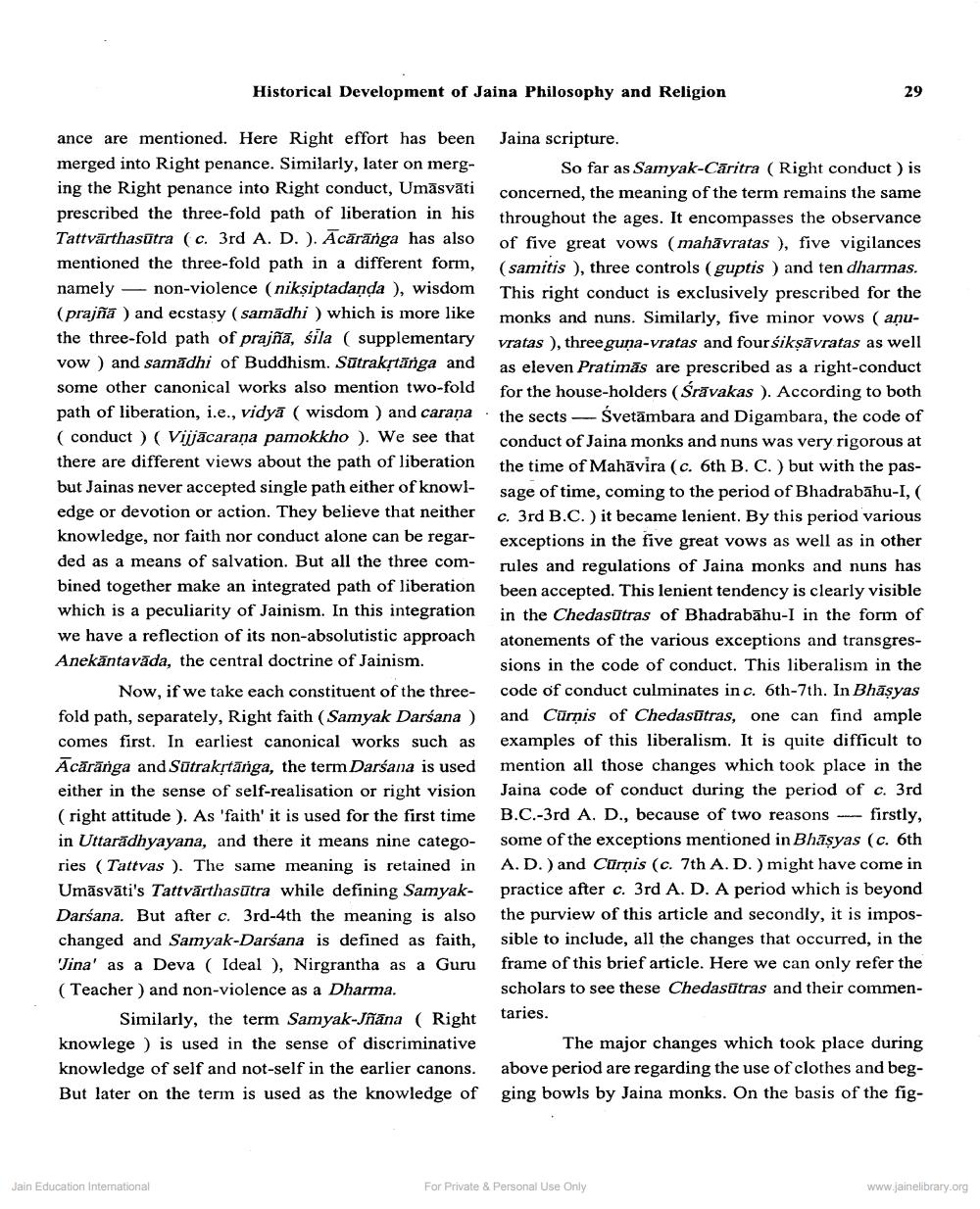________________
Historical Development of Jaina Philosophy and Religion
29
ance are mentioned. Here Right effort has been Jaina scripture. merged into Right penance. Similarly, later on merg
So far as Samyak-Caritra (Right conduct ) is ing the Right penance into Right conduct, Umāsvāti
concerned, the meaning of the term remains the same prescribed the three-fold path of liberation in his throughout the ages. It encompasses the observance Tattvārthasūtra (c. 3rd A. D. ). Acāränga has also of five great vows (mahāvratas ), five vigilances mentioned the three-fold path in a different form, (samitis ), three controls (guptis ) and ten dharmas. namely — non-violence (nikşiptadanda ), wisdom This right conduct is exclusively prescribed for the (prajña ) and ecstasy (samadhi ) which is more like monks and nuns. Similarly, five minor vows ( anuthe three-fold path of prajña, sila ( supplementary Vratas ), three guna-vratas and four sikşāvratas as well vow) and samadhi of Buddhism. Satraktänga and as eleven Pratimās are prescribed as a right-conduct some other canonical works also mention two-fold for the house-holders (Śrävakas ). According to both path of liberation, i.e., vidya (wisdom ) and carana - the sects Svetämbara and Digambara, the code of (conduct ( Viljacarana pamokkho ). We see that conduct of Jaina monks and nuns was very rigorous at there are different views about the path of liberation the time of Mahāvira (c. 6th B. C.) but with the pasbut Jainas never accepted single path either of knowl
sage of time, coming to the period of Bhadrabāhu-I, ( edge or devotion or action. They believe that neither c. 3rd B.C.) it became lenient. By this period various knowledge, nor faith nor conduct alone can be regar- exceptions in the five great vows as well as in other ded as a means of salvation. But all the three com- rules and regulations of Jaina monks and nuns has bined together make an integrated path of liberation been accepted. This lenient tendency is clearly visible which is a peculiarity of Jainism. In this integration in the Chedasūtras of Bhadrabahu-l in the form of we have a reflection of its non-absolutistic approach atonements of the various exceptions and transgresAnekāntavāda, the central doctrine of Jainism.
sions in the code of conduct. This liberalism in the Now, if we take each constituent of the three- code of conduct culminates in c. 6th-7th. In Bhāsyas fold path, separately, Right faith (Samyak Darśana ) and Cūrņis of Chedasūtras, one can find ample comes first. In earliest canonical works such as examples of this liberalism. It is quite difficult to Acărănga and Sūtraktārga, the term Darsana is used mention all those changes which took place in the either in the sense of self-realisation or right vision Jaina code of conduct during the period of c. 3rd (right attitude). As 'faith' it is used for the first time B.C.-3rd A. D., because of two reasons - firstly, in Uttarădhyayana, and there it means nine catego- some of the exceptions mentioned in Bhäsyas (c. 6th ries (Tattvas ). The same meaning is retained in A. D.) and Curnis (c. 7th A. D.) might have come in Umāsvāti's Tattvārthasūtra while defining Samyak- practice after c. 3rd A. D. A period which is beyond Darsana. But after c. 3rd 4th the meaning is also the purview of this article and secondly, it is imposchanged and Samyak-Darsana is defined as faith, sible to include, all the changes that occurred, in the Vina' as a Deva (Ideal ), Nirgrantha as a Guru frame of this brief article. Here we can only refer the ( Teacher and non-violence as a Dharma.
scholars to see these Chedasūtras and their commenSimilarly, the term Samyak-Jrāna ( Right taries. knowlege ) is used in the sense of discriminative
The major changes which took place during knowledge of self and not-self in the earlier canons. above period are regarding the use of clothes and begBut later on the term is used as the knowledge of ging bowls by Jaina monks. On the basis of the fig
Jain Education International
For Private & Personal Use Only
www.jainelibrary.org




